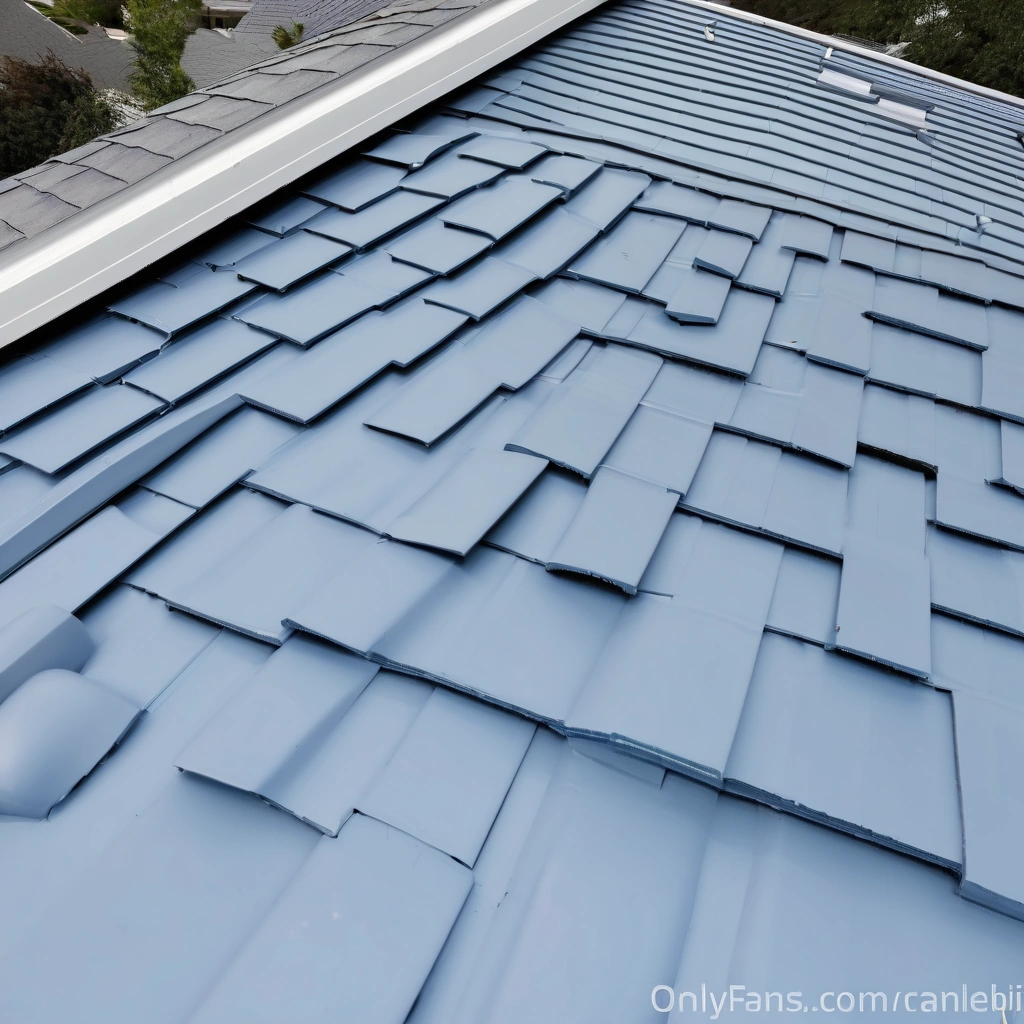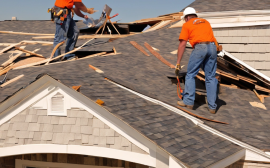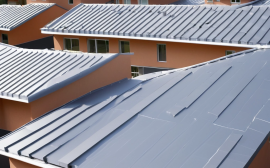Introduction
Imagine your home on a sweltering summer day. While the sun beats down, your roof absorbs a significant portion of that solar radiation, transferring the heat into your living space. This forces your air conditioning to work overtime, driving up your energy bills and increasing your carbon footprint. The color of your roof plays a crucial role in this process. Darker roofs absorb more heat, while lighter, more reflective roofs, often referred to as “cool roofs,” can significantly reduce heat absorption and subsequently lower cooling costs.
This introduction explores the impact of roof color on energy efficiency, offering valuable insights for homeowners seeking sustainable and cost-effective home improvements. By understanding the science behind roof color and its impact on energy consumption, you can make informed decisions to enhance your home’s comfort and contribute to a greener future. The concept of “cool roofs” is rooted in the principles of solar reflectance and thermal emittance. A highly reflective roof, typically light in color, bounces sunlight back into the atmosphere rather than absorbing it.
This simple principle can dramatically reduce the amount of heat transferred into your home. The Environmental Protection Agency (EPA) estimates that a cool roof can lower rooftop temperatures by up to 50 degrees Fahrenheit, resulting in significant energy savings. Moreover, choosing a “cool roof” translates to a smaller energy footprint, contributing to a more sustainable way of living. For homeowners seeking both economic and environmental benefits, exploring cool roof options can be a smart investment.
Incorporating “cool roof” technology aligns perfectly with the principles of green building and sustainable living. By reducing energy consumption, cool roofs contribute to lower greenhouse gas emissions and lessen the strain on power grids, particularly during peak summer months. According to the Lawrence Berkeley National Laboratory, cool roofs can reduce annual cooling energy use by 10-30%. This translates to tangible savings on your energy bills and a smaller impact on the environment. For those pursuing home improvement projects with an eye towards energy efficiency, a cool roof should be a serious consideration.
Beyond the immediate benefits to individual homeowners, the widespread adoption of cool roofs offers significant community-wide advantages. By reducing the urban heat island effect, where densely populated areas experience higher temperatures than surrounding regions, cool roofs can contribute to cooler cities and improved air quality. This collective impact underscores the importance of considering roof color not only as a personal home improvement choice but also as a contribution to a more sustainable and resilient community.
By understanding the interplay between roof color, energy efficiency, and environmental impact, homeowners can make informed choices that benefit both their wallets and the planet. Navigating the world of cool roofs can seem daunting, but with the right information, homeowners can make choices that align with their individual needs and budget. This article will delve into the science behind cool roofs, explore various cool roof options, discuss the impact of roof color in different climates, and provide practical tips for homeowners considering a cool roof installation. Whether you are planning a new roof or simply looking for ways to improve your home’s energy performance, understanding the cool roof advantage is a crucial step towards creating a more comfortable, efficient, and environmentally friendly home.
Solar Reflectance and Thermal Emittance
The Science of Cool Roofs: Reflecting Sunlight, Reducing Heat Cool roofs offer a compelling approach to energy efficiency and home improvement by harnessing fundamental principles of physics to minimize solar heat absorption. Unlike traditional dark roofs that absorb a significant portion of the sun’s energy, cool roofs are designed to reflect sunlight back into the atmosphere, thereby reducing the amount of heat transferred into the building. This reflective quality, known as solar reflectance, is a key factor in determining a roof’s cooling efficiency.
A high solar reflectance value indicates a greater ability to repel sunlight and keep the building cooler. For instance, a white roof can reflect up to 80% of solar radiation, while a dark roof might reflect as little as 10%. This difference translates directly into lower indoor temperatures and reduced reliance on air conditioning, leading to significant energy savings and a smaller carbon footprint. Thermal emittance, another crucial property of cool roofs, measures how effectively a roof surface releases absorbed heat.
Even with high solar reflectance, some solar energy will inevitably be absorbed. Cool roofs are designed to efficiently radiate this absorbed heat away from the building, minimizing heat buildup. Materials like specialized coatings and tiles are engineered to maximize thermal emittance, further enhancing the cooling effect. This combination of high solar reflectance and high thermal emittance is what defines a cool roof and sets it apart from conventional roofing options. By minimizing both heat absorption and retention, cool roofs contribute significantly to a more comfortable and energy-efficient home environment.
The benefits of cool roofs extend beyond individual homeowners to encompass broader environmental advantages aligned with green building principles. By reducing the urban heat island effect, cool roofs contribute to lower ambient temperatures in cities, mitigating the strain on power grids during peak summer months. This, in turn, reduces the demand for electricity generated from fossil fuels, lessening greenhouse gas emissions and promoting sustainable living. For homeowners, the impact on cooling costs is often substantial, making cool roofs a financially sound home improvement investment.
Coupled with the environmental benefits, cool roofs offer a compelling solution for those seeking to reduce their environmental impact. In the context of green building, cool roofs are an essential component of sustainable design, contributing to LEED certification points and aligning with broader initiatives for energy-efficient construction. They represent a tangible step towards creating more environmentally responsible buildings and communities. When considering a roofing project, exploring cool roof options provides homeowners with a chance to make a positive impact on both their energy bills and the environment.
From reflective coatings to specialized tiles, the array of available cool roof technologies provides a range of options to suit various budgets and aesthetic preferences. By understanding the science behind cool roofs, homeowners can make informed decisions that contribute to a more sustainable and comfortable living environment. Choosing the right cool roof involves considering factors such as climate, roof slope, and the overall design of the home. In warmer climates, the benefits of cool roofs are particularly pronounced, offering substantial energy savings during hot summer months.
However, even in milder climates, the reflective properties of cool roofs can contribute to a more comfortable indoor environment and reduced energy consumption. Consulting with a roofing professional experienced in cool roof technology can provide valuable insights and guidance in selecting the most appropriate solution for a specific home and location. This expert advice can ensure that the chosen cool roof effectively addresses the homeowner’s needs and maximizes the potential for energy efficiency and cost savings.
The Impact of Roof Color in Different Climates
Light vs. Dark: Choosing the Right Roof for Your Climate. The impact of roof color on energy efficiency is heavily influenced by regional climate. While a white or light-colored cool roof excels at reflecting sunlight and minimizing heat absorption in sunny, warm climates, its benefits diminish in colder regions where solar heat gain can help offset heating costs. Understanding these regional nuances is crucial for homeowners aiming to maximize energy savings through informed roofing choices.
For example, a homeowner in Arizona might see a significant reduction in cooling costs by opting for a highly reflective white roof, whereas a homeowner in Maine might find a darker roof more beneficial overall, especially during the long winter months. This decision directly impacts home improvement budgets and contributes to sustainable living practices. In warmer climates, the primary goal is to minimize solar heat gain. Light-colored roofs, particularly those with high solar reflectance, are ideal for reflecting a significant portion of the sun’s energy away from the building.
This reduces the amount of heat transferred into the attic and living spaces, lessening the demand on air conditioning systems. Studies have shown that cool roofs can lower roof temperatures by as much as 50-60°F compared to traditional dark roofs, translating into substantial savings on cooling costs. Reflective roofing materials like white tile, coated metal, and specialized cool roof coatings are excellent choices for homeowners in these regions seeking to improve energy efficiency and contribute to green building practices.
Conversely, in colder climates, the objective shifts towards maximizing solar heat gain during the heating season. Darker roofs absorb more sunlight, which can help warm the building and reduce reliance on heating systems. While a dark roof might increase cooling costs slightly during the summer, the overall energy savings during the winter can outweigh this disadvantage. However, it’s important to note that even in colder climates, extremely dark roofs can still contribute to overheating during the summer months, so careful consideration of insulation levels and ventilation is essential.
Homeowners should also consider the potential for increased snow melt-off from darker roofs, which could impact gutter systems and create ice damming issues. Beyond just light versus dark, the specific type of roofing material also plays a significant role in energy performance. For instance, metal roofs, regardless of color, tend to be more reflective than asphalt shingles due to their inherent properties. Cool roof coatings can be applied to various roofing materials, including asphalt shingles, to increase their reflectivity and thermal emittance.
These coatings are often formulated with specialized pigments that reflect infrared radiation, further reducing heat absorption. When making home improvement decisions, homeowners should consider the long-term durability and maintenance requirements of different roofing materials, as well as their energy-saving potential. Ultimately, the best roof color for your home depends on a careful assessment of your local climate, building orientation, insulation levels, and energy consumption patterns. Consulting with a qualified roofing contractor or energy auditor can provide valuable insights and help you make an informed decision that balances energy efficiency, aesthetic preferences, and budget considerations. Remember to factor in local building codes and regulations, as some municipalities offer incentives or rebates for installing cool roofs as part of their green building initiatives. By considering these factors, homeowners can make roofing choices that not only enhance their home’s value but also contribute to a more sustainable and energy-efficient future.
Exploring Cool Roof Options
Cool Roof Technology: A Deep Dive into Materials and Methods The evolution of cool roof technology represents a significant advancement in sustainable building practices, offering homeowners and building managers alike a tangible means of reducing energy consumption and mitigating the urban heat island effect. Cool roofs achieve their energy-saving prowess through two primary mechanisms: high solar reflectance, which measures the roof’s ability to reflect sunlight away from the building, and high thermal emittance, which quantifies its capacity to release absorbed heat.
Traditional roofing materials, particularly dark-colored asphalt shingles, absorb a significant portion of solar radiation, leading to increased roof temperatures and subsequent heat transfer into the building. Cool roofing materials, on the other hand, are designed to minimize this heat absorption, keeping the building cooler and reducing the reliance on air conditioning systems. This translates directly into lower energy bills and a reduced carbon footprint, aligning with both home improvement and green building objectives. Several types of cool roofing materials are available, each with its own set of characteristics and benefits.
Reflective coatings, often applied to existing roofs, provide a cost-effective way to enhance solar reflectance and thermal emittance. These coatings, typically made from acrylic, polyurethane, or elastomeric materials, can be applied to various roofing surfaces, including asphalt, metal, and concrete. Single-ply membranes, such as TPO (thermoplastic polyolefin) and PVC (polyvinyl chloride), are another popular option for commercial and residential buildings. These membranes offer excellent durability, weather resistance, and high reflectivity. Furthermore, cool roof shingles, incorporating reflective granules, are gaining traction as a viable alternative to traditional asphalt shingles, offering homeowners an aesthetically pleasing way to improve energy efficiency.
The choice of material often depends on factors such as budget, roof slope, aesthetic preferences, and local climate conditions. Beyond coatings and membranes, innovative roofing technologies are continuously emerging. Green roofs, also known as vegetative roofs, represent a more holistic approach to cool roofing. These roofs feature a layer of vegetation planted over a waterproof membrane, providing insulation, reducing stormwater runoff, and creating a natural habitat. While green roofs require more upfront investment and maintenance, they offer significant environmental benefits and can enhance property value.
Another emerging technology involves the use of cool pigments in roofing materials. These pigments are designed to reflect infrared radiation, which is a major component of sunlight, without significantly altering the color of the roof. This allows for the creation of cool roofs in a wider range of colors, expanding design possibilities while maintaining energy efficiency. Selecting the appropriate cool roof material requires careful consideration of several factors, including climate, roof slope, building type, and budget.
In hot, sunny climates, highly reflective materials are essential for maximizing energy savings. In colder climates, a balance between reflectivity and heat absorption may be desirable to reduce heating costs during the winter months. The roof slope also plays a role, as steeper slopes tend to shed water more effectively, making certain materials more suitable. Furthermore, it’s crucial to consult with a qualified roofing contractor to ensure proper installation and to address any potential issues, such as moisture buildup or compatibility with existing roofing systems.
Proper installation is paramount to achieving the desired energy-saving benefits and ensuring the long-term performance of the cool roof. Government incentives and rebates are often available to encourage the adoption of cool roofing technologies. Many states and municipalities offer financial assistance to homeowners and building owners who install cool roofs, recognizing the significant energy savings and environmental benefits associated with these systems. The ENERGY STAR program, a joint initiative of the U.S. Environmental Protection Agency (EPA) and the U.S. Department of Energy (DOE), provides guidelines and certifications for cool roofing products that meet specific performance criteria. Checking for ENERGY STAR certification is a good way to ensure that a roofing material meets industry standards for reflectivity and emittance. By taking advantage of available incentives and choosing certified products, homeowners can make a cost-effective investment in a more sustainable and energy-efficient future.
Practical Tips for Homeowners
Making Informed Choices: Assessing Your Roof and Planning for the Future Choosing a cool roof involves careful consideration of your home’s specific needs and your long-term goals. A thorough roof assessment is the first step. This includes evaluating the current roof’s condition, age, and material. For homeowners considering a replacement, exploring cool roof options early in the planning process is crucial for maximizing energy savings and ensuring the chosen material aligns with the home’s architectural style.
If a full replacement isn’t feasible, consider cool roof coatings that can be applied to existing roofs, offering a cost-effective way to enhance reflectivity. Understanding the energy efficiency potential of a cool roof requires examining your local climate. In hotter climates, a highly reflective roof can significantly reduce cooling costs by minimizing the amount of solar heat absorbed. “A white or light-colored cool roof can reflect up to 80% of sunlight, dramatically reducing the roof’s temperature and the subsequent heat transfer into the home,” explains Dr.
Sarah Miller, a building scientist specializing in sustainable roofing. This translates to lower energy bills and a smaller carbon footprint. However, in colder climates where maximizing solar heat gain in winter is desirable, a moderate approach to roof reflectivity is recommended. Consulting with a roofing professional experienced in energy-efficient roofing solutions is invaluable for tailoring the best approach to your specific climate and home. The choice of cool roof material is another critical factor. Reflective shingles, tiles, and coatings are available in a variety of colors and styles to suit different aesthetic preferences. “Advances in cool roof technology have led to the development of pigmented coatings that offer excellent reflectivity while also providing vibrant color options,” notes architect John Davis, a proponent of green building practices.
This allows homeowners to maintain their desired curb appeal while enjoying the benefits of a cool roof. For those seeking environmentally friendly options, consider roofing materials made from recycled content or materials with low embodied carbon. Some cool roof products even qualify for rebates and incentives, further enhancing their economic appeal. Beyond the immediate benefits of reduced cooling costs, cool roofs contribute to a more sustainable future. By mitigating the urban heat island effect, cool roofs help lower ambient temperatures in cities, reducing the strain on power grids and improving overall air quality. “The cumulative effect of widespread cool roof adoption can significantly impact a city’s energy consumption and contribute to broader climate change mitigation efforts,” emphasizes Dr.
Miller. For homeowners, choosing a cool roof is a tangible step towards creating a more energy-efficient and environmentally responsible home, while also enjoying long-term cost savings and enhanced comfort. Finally, consider the long-term maintenance requirements of your chosen cool roof material. While cool roofs generally require similar maintenance to traditional roofs, understanding the specific needs of your chosen material will ensure its longevity and optimal performance. Regular inspections, cleaning, and prompt repairs are essential for maximizing the lifespan and energy-saving potential of any roof, including cool roofs. By considering these factors, homeowners can make informed decisions that align with their budget, aesthetic preferences, and commitment to sustainable living.
Conclusion
Investing in a cool roof is more than just a home improvement project; it’s a commitment to energy efficiency, green building, and sustainable living. By reflecting sunlight and reducing heat absorption, cool roofs offer significant long-term benefits that extend beyond mere aesthetics. Homeowners can reap the rewards of lower energy bills, a smaller carbon footprint, and increased roof lifespan. The initial investment in a cool roof translates into substantial savings on cooling costs over time, especially in warmer climates.
Studies by the Department of Energy have shown that cool roofs can reduce peak cooling demand by 10-15%, leading to significant annual energy savings. This translates directly into lower monthly utility bills, freeing up resources for other home improvement projects or investments. Furthermore, the reduced energy consumption contributes to a smaller carbon footprint, aligning with green building principles and promoting a more sustainable lifestyle. By lessening the strain on power grids, particularly during peak summer months, cool roofs contribute to a more resilient and environmentally responsible energy infrastructure.
The enhanced reflectivity also extends the lifespan of the roof itself, minimizing wear and tear caused by prolonged exposure to intense heat and UV radiation. This translates into delayed roof replacement costs, further enhancing the return on investment. Beyond the financial and environmental benefits, cool roofs contribute to improved indoor comfort, especially in homes without adequate insulation. By reducing heat transfer into the attic, cool roofs help maintain a more consistent indoor temperature, reducing the need for excessive air conditioning.
This improved thermal comfort enhances the overall livability of the home and contributes to a healthier indoor environment. From asphalt shingles with special reflective coatings to tiles and metal roofing designed for maximum solar reflectance, there’s a cool roof option to suit every architectural style and budget. Consulting with a qualified roofing professional can help homeowners navigate the various options and choose the best solution for their specific needs and climate. By considering factors such as roof slope, local climate conditions, and overall energy efficiency goals, homeowners can make informed decisions that maximize the benefits of cool roofing technology.
Incorporating cool roofs into building design and renovation projects is a crucial step towards creating more sustainable and resilient communities. As awareness of the benefits of cool roofs grows, they are becoming an increasingly popular choice for both new constructions and roof replacements, contributing to a greener future for all. Whether motivated by financial savings, environmental responsibility, or enhanced comfort, the advantages of cool roofs are undeniable. By making a conscious choice to invest in this innovative technology, homeowners can contribute to a more sustainable future while enjoying the tangible rewards of lower energy bills and a more comfortable home.



